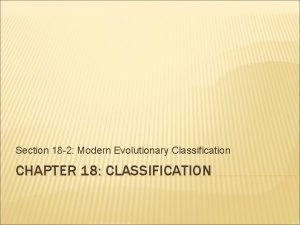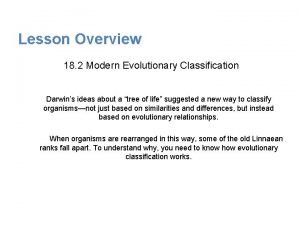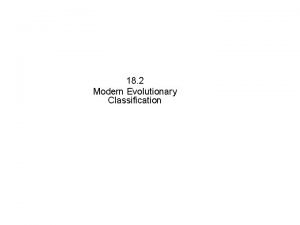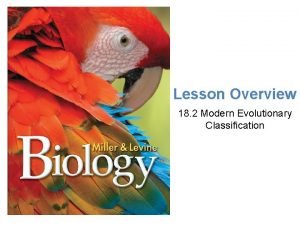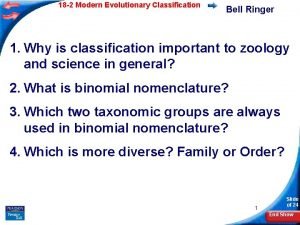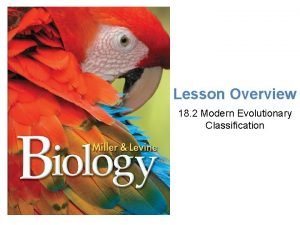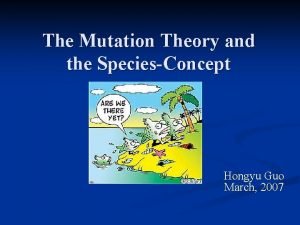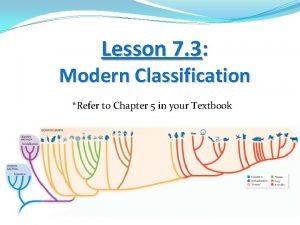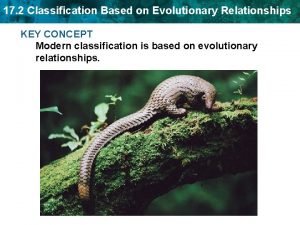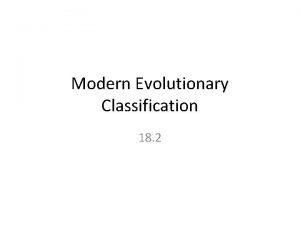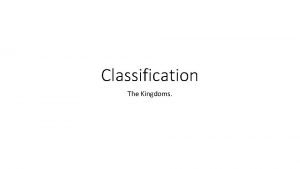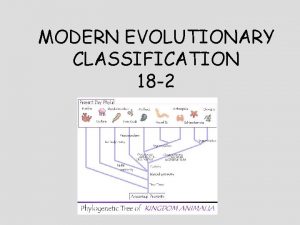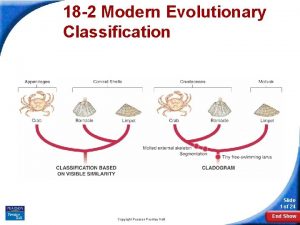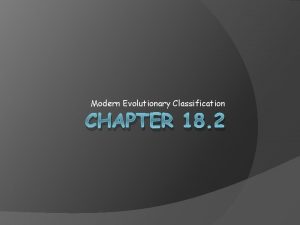18 2 Modern Evolutionary Classification Evolutionary Classification The



















- Slides: 19

18. 2 Modern Evolutionary Classification

Evolutionary Classification • The concept of descent with modification led to phylogeny— the study of how living and extinct organisms are related to one another. • Advances in phylogeny, in turn, led to phylogenetic systematics, or evolutionary classification. Phylogenetic systematics groups species into larger categories that reflect lines of evolutionary descent, rather than overall similarities and differences.

Clades • A clade is a group of species that includes a single common ancestor and all descendants of that ancestor—living and extinct. • A clade must be a monophyletic group. A monophyletic group must include all species that are descended from a common ancestor, and cannot include any species that are not descended from that common ancestor.

Cladograms • Modern evolutionary classification uses a method called cladistic analysis to determine how clades are related to one another. • This information is used to link clades together into a cladogram, which illustrates how groups of organisms are related to one another by showing how evolutionary lines, or lineages, branched off from common ancestors.

Building Cladograms • A speciation event, in which an ancestral lineage branches into two new lineages, is the basis for each branch point, or node. Each node represents the last point at which the new lineages shared a common ancestor. • The bottom, or “root, ” of the tree represents the common ancestor shared by all organisms on the cladogram.

Building Cladograms • A cladogram’s branching patterns indicate degrees of relatedness among organisms. • Because lineages 3 and 4 share a common ancestor more recently with each other than they do with lineage 2, you know that lineages 3 and 4 are more closely related to each other than they are with lineage 2.

Building Cladograms • Likewise, lineages 2, 3, and 4 are more closely related, in terms on ancestry, with each other than any of them is to lineage 1.

Building Cladograms • This cladogram represents current hypotheses about evolutionary relationships among vertebrates. • Note that in terms of ancestry, amphibians are more closely related to mammals than they are to ray-finned fish.

Derived Characters • In contrast to Linnaean classification, cladistic analysis focuses on certain kinds of characters, called derived characters, when assigning organisms into clades. • A derived character is a trait that arose in the most recent common ancestor of a particular lineage and was passed along to its descendants.

Reading Cladograms • This cladogram shows a simplified phylogeny of the cat family.

Reading Cladograms • The lowest node represents the last common ancestor of all four-limbed animals—members of the clade Tetrapoda

Reading Cladograms • The forks show the order in which various groups branched off over the course of evolution.

Reading Cladograms • The positions of the derived characters on the cladogram reflect the order in which those characteristics arose in this lineage.

Reading Cladograms • The trait of four limbs, for example, appeared before the trait of hair in the history of the cat’s lineage.

Reading Cladograms • Each derived character defines a clade. Hair, for example, is a defining character for the clade Mammalia.

Reading Cladograms • Retractable claws is a derived character shared only by members of the clade Felidae.

Reading Cladograms • Smaller clades are nested within the larger clades. Clade Amniota is part of the larger clade Tetrapoda.

New Techniques Suggest New Trees • Often, scientists use DNA evidence when anatomical traits alone can’t provide clear answers. • For example, giant pandas and red pandas share many characteristics with both bears and raccoons.

New Techniques Suggest New Trees • DNA analysis revealed that the giant panda shares a more recent common ancestor with bears than with raccoons. Therefore, the giant panda has been placed in a clade with bears. • Red pandas, however, are in a clade with raccoons and other animals like weasels and seals.
 18-2 modern evolutionary classification
18-2 modern evolutionary classification Modern evolutionary classification
Modern evolutionary classification Section 18-2 modern evolutionary classification
Section 18-2 modern evolutionary classification 18-2 modern evolutionary classification
18-2 modern evolutionary classification Red panda life cycle
Red panda life cycle 18-2 modern evolutionary classification answer key
18-2 modern evolutionary classification answer key Modern evolutionary classification
Modern evolutionary classification Modern evolutionary synthesis
Modern evolutionary synthesis Traditional classification vs modern classification
Traditional classification vs modern classification Based on evolutionary relationships
Based on evolutionary relationships Classification based on evolutionary relationships
Classification based on evolutionary relationships Hình ảnh bộ gõ cơ thể búng tay
Hình ảnh bộ gõ cơ thể búng tay Slidetodoc
Slidetodoc Bổ thể
Bổ thể Tỉ lệ cơ thể trẻ em
Tỉ lệ cơ thể trẻ em Voi kéo gỗ như thế nào
Voi kéo gỗ như thế nào Chụp phim tư thế worms-breton
Chụp phim tư thế worms-breton Chúa sống lại
Chúa sống lại Các môn thể thao bắt đầu bằng tiếng chạy
Các môn thể thao bắt đầu bằng tiếng chạy Thế nào là hệ số cao nhất
Thế nào là hệ số cao nhất
